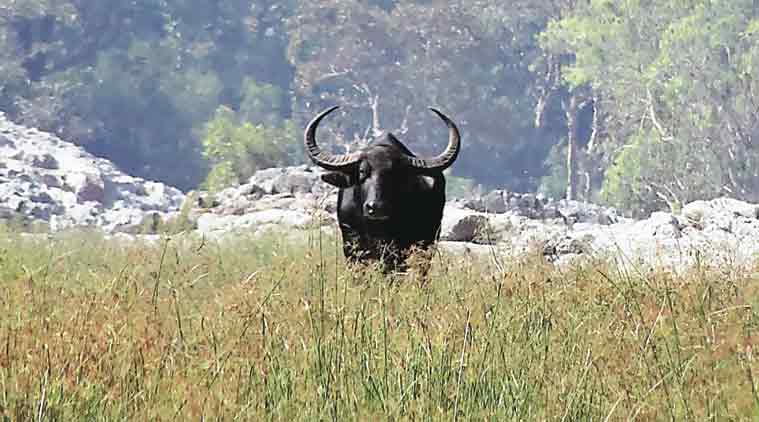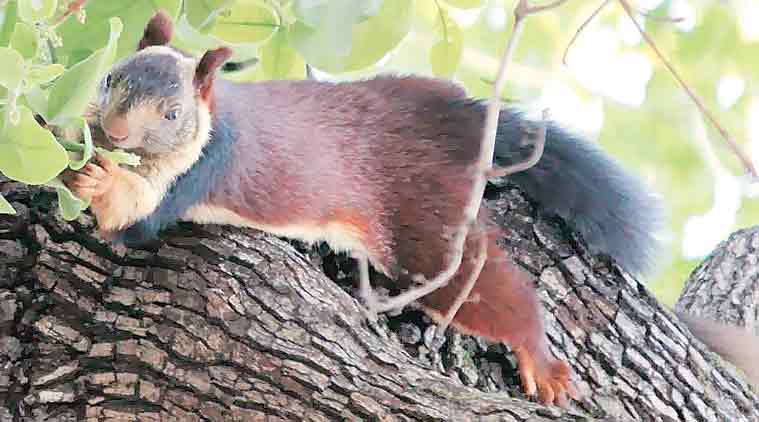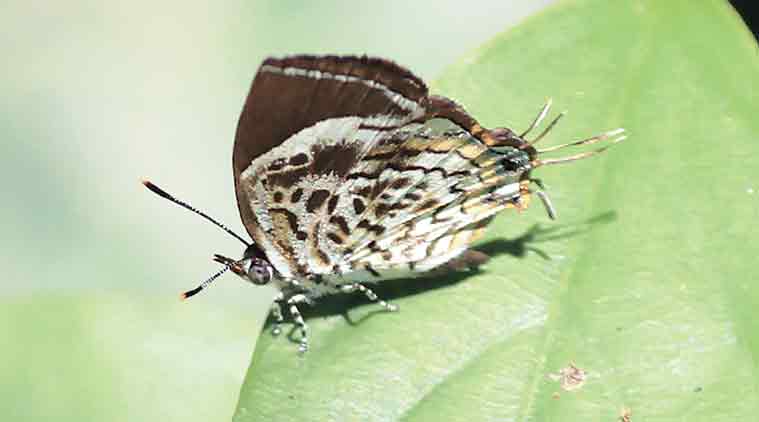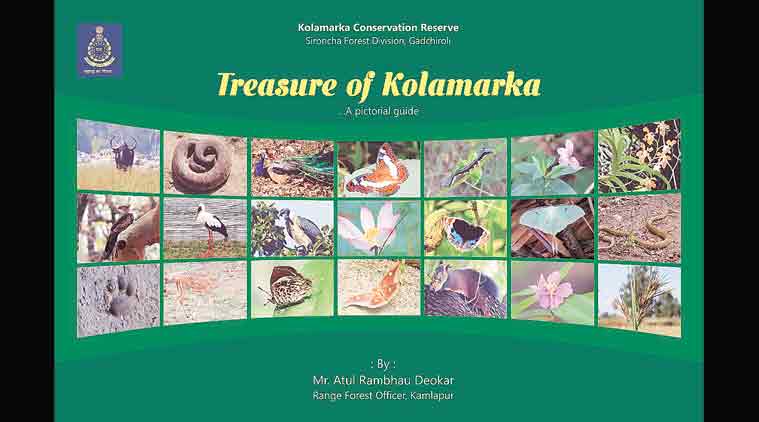- India
- International
Young forest officer leads first wildlife survey in ‘liberated’ Naxal heartland
Two-year effort involving locals culminates in discovery of rare species, some believed to be extinct.
 The wild water buffalo thought to be extinct. (Express Photo)
The wild water buffalo thought to be extinct. (Express Photo)
For many years, wildlife scientists, activists and enthusiasts have tried to spot and photograph the near-extinct and elusive wild water buffalo of central India in the virtually impregnable terrain of the Kolamarka area of Gadchiroli’s Aheri tehsil, with little or no success.
But between January and May this year, the Maharashtra Forest Department ground staff, with help from local villagers, not only managed to spot the buffalo herd but also managed to photograph them.The exploration has also laid to rest the speculation that only one female was left in the entire central Indian landscape – the herd was found to be having at least four females.
While this development, first reported by The Indian Express, brought cheer among conservationists, it was the culmination of a silent effort by a handful of forest officials led by a young Range Forest Officer (RFO) Atul Deokar to document the flora and fauna of the area that was hitherto unrecorded, since it lay in the ‘liberated’ zone of gun-wielding Maoists.
 The Shekru or the giant squirrel, Maharashtra’s state animal. (Express Photo)
The Shekru or the giant squirrel, Maharashtra’s state animal. (Express Photo)
The success of the effort has also demolished the long-held myth that no work can be undertaken in the Naxal-dominated landscape.
The exercise was aimed at documenting the area declared as the Kolamarka Conservation Reserve in January 2013.

The 180-km reserve is a virtual paradise dotted with beautiful hillocks, seasonal and perennial streams, thick vegetation and beautiful falls on Bande and Indravati rivers that separate Gadchiroli in Maharashtra from the state of Chhattisgarh.
Deokar spearheaded a small group of local villagers and his ground staff to register with photographic and other evidence, over 65 species of butterflies, 114 species of birds, about 1,200 nests of Maharashtra’s State Animal Shekru (giant squirrel), 33 types of grasses, over 180 individual vultures of both white back and long-billed types, 19 different reptiles (still counting), leopards, pangolins, crocodiles, wild boars, chitals, sloth bears and the mouse deer. There are langoors and red-faced macaques too.
The findings have been compiled in a smartly packaged book called Treasure of Kolamarka, the first authentic account of the reserve’s biodiversity.
No tiger, however, has been cited so far despite the Indravati Tiger Reserve in Chhattisgarh lying close by.
“After the declaration of the findings, we started drafting the Management Plan for the area. It was necessary to systematically record the biodiversity but the challenge was daunting due to the 90 per cent thick vegetation cover, hilly terrain and, of course the Naxal presence,” said Deokar, who has just completed his three-year tenure as Kamlapur RFO before being transferred to the Pench Tiger Reserve.
 The monkey puzzle, a rare species of butterfly. (Express Photo)
The monkey puzzle, a rare species of butterfly. (Express Photo)
Kamlapur, incidentally, is where Naxals had held their first Congress and the Kolamarka reserve is largely covered by the Kamlapur range.
Supported by Gadchiroli Chief Conservator of Forests P S K Reddy and Deputy Conservators of Forests (DCFs) Shri Lakshmi and Prabhunath Shukla, Deokar and his team began the campaign by getting local villagers on board through a long process of dialogue.
“There are four villages in the core area, Chintarev, Chitveli, Tonder and Bangaram Petha; and four on the fringes of the reserve, Nayangodam, Asha, Damrancha and Mudumudgu. We formed eco-development committees (EDCs) in the villages and carried out some developmental activities like reservoirs, solar lamps, smokeless chulahs, and LPG connections. A defunct borewell was also rejuvenated,” Deokar said.
We selected nine volunteers to form a monitoring team and gave them geo-tagged cameras to be able to get exact GPS location of the spots where they would record evidence and take photographs. The team would often trek upto 25 km to record the biodiversity,” he added.
The villagers were happy since they earned up to Rs 7,500 per month in wages. The move paid off with the team recording and photographing, among many other things, a herd of wild buffaloes earlier this year.
“It’s a very valuable record. It shows extremely pure and hefty buffaloes, including at least four females. It has given a new hope for the revival of the near-extinct central Indian wild water buffalo,” said Rajiv Mathew, a member of National Biodiversity Authority (NBA).
The monitoring team has confirmed existence of at least two herds of nine and six members and an individual bull living separately.
“At least four new butterflies — Common Banded Peacock, Common Palm Fly, Monkey Puzzle and Common Evening Brown — were recorded for the first time in Vidarbha,” said Deokar, who mapped all 65 butterfly species himself.
The core villages have domesticated buffaloes but chances of the wild variety getting corrupted are virtually zero, since the wild buffaloes never come anywhere close to these villages. “Yet, we have chalked out a cattle replacement plan where the buffaloes would be taken off and villagers would be provided with cows and bullocks to prevent any such remote possibility,” Deokar said.
“Many conservation activities were also undertaken like chain-link fenced “vulture restaurants” away from villages where villagers would be paid Rs 250 for each dead animal they would provide for the vultures to feed. This has led significant increase in vulture numbers,” Deokar said. A separate study is now being undertaken to register plant biodiversity.
 Cover of Treasure of Kolamarka documenting the biodiversity of the reserve.
Cover of Treasure of Kolamarka documenting the biodiversity of the reserve.
The exercise, however, has not been without hindrances. “Naxals did not generally oppose developmental works, but destroyed our protection huts. They are worried for their locations getting leaked out,” Deokar said.
He, however, added that he never encountered Naxals during the three-year exercise.
Recently, Naxals blasted the Decchli range office of the Forest Department by using two of the LPG cylinders meant for distribution to villagers and warned the staff not to venture out in the forest. Deokar, however, is confident that with due precaution, the incomplete biodiversity register of Kolamarka can eventually be completed.
“These kinds of hazards are part of the game in this area. The two most important things to be observed and practised in Naxal areas are honesty and involvement of locals,” he said.
Apr 24: Latest News
- 01
- 02
- 03
- 04
- 05







































